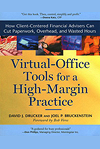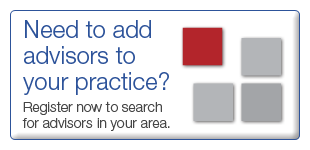With a passion for the success of the smaller financial planning practice, David Drucker, a regular columnist for Financial Planning Magazine and Joel Bruckenstein, the Senior Technology Editor for Morningstar Advisor came together to write Virtual Office Tools for a High-Margin Practice in 2001, published by Bloomberg Press. Both men are planners themselves. The book guides you on why and how to use virtual office tools and techniques for greater profitability. The authors examine the growing opportunities advisors have to outsource virtually any administrative or technical office function for greater operating efficiency and profitability. Most books with perishable information are revised every couple of years. Authors Drucker and Bruckenstein decided that to accommodate the more frequent technological innovations available to advisors a monthly newsletter would be best. So in January of 2003, they launched Virtual Office News. They have since renamed the newsletter Technology Tools for Today. They now also hold an annual conference by the same name. A recent book of theirs is Tools and Techniques of Practice Management (2004).
Technology Tools for Today
The newsletter keeps subscribers abreast of the latest news on virtual office tools and technology. It also discusses how advisors are actually making the virtual office work for them. Guest columnists are featured and a Price Watch is periodically posted to alert you to the best prices on recommended hardware and software.
Virtual Office Tools
The book, Virtual Office Tools, breaks down a conversion to a virtual office into four phases making it more manageable to implement either partially or completely. The first is to convert physical records to digital records, ie scanning. The second is to convert employees to virtual workers. Next, you need to establish systems to accommodate your off-site workers. And last, you must install systems that facilitate the retrieval of your digital information. The task at hand is for you to comb through all of your firm-wide systems looking for opportunities to improve efficiencies.
Converting Physical to Digital Records
Virtual Tools walks you through the steps in the conversion of physical records. Historical records will need to be scanned and filed. Scanning is a menial task and is something you can hire a low-paid temporary worker to do since it just involves feeding paper into a machine. Filing, however, is something you will want either to do yourself or to have an experienced employee to do under your supervision. You need to identify subdirectories and labels so that information retrieval is efficient. You will also need to go through your client files and decide what to keep and what to throw out before beginning the scanning process. Scanning software and hardware are discussed in the book based on the size and scope of your practice.
Converting from Employees to Virtual Workers: The Process and the Economics
If you are going to add people, add them because they will enhance client service to the net benefit of the firm, not because inefficient systems require more people. The reason for using technology, such as a paperless system, is to raise the productivity of the minimum number of staff needed to maximize the virtual owner’s bottom line in the context of the lifestyle and work style he or she wants to have. So, for example, if we are comparing the cost of dedicating an employee to client reporting (i.e. downloading and reconciling custodial trade data within a program such as Centerpiece) against using a virtual counterpart to carry out this function, the framework for your employee cost analysis must include all of the cost items that would be avoided with the virtual option (i.e. salary, training, benefits, office space, office equipment, etc.).
Converting Systems to Accommodate Off-Site Workers
Virtual workers can live thousands of miles from your office, or your own employees living locally but desire to work from home. An example of converting a system: historically, the paper versions of research material limited your flexibility as there was one copy of the paper version of for example Morningstar’s Mutual Fund Values in the office. Services were then delivered in the form of CD-ROMs. Now these services are Web-based and it makes it possible for your workforce to do their research anywhere, anytime.
Installing Systems for Digital Retrieval of Information
The digital systems you use should facilitate rapid retrieval of information. One of your objectives should be to eliminate multiple and duplicative software programs, lost client files, client phone tag, and other sources of inefficiency in how you receive, store, retrieve, and use all of the various types of information on which your service depends. The book reviews multiple systems and provides a host of contacts and resources as well.
The response from this book and articles written by the authors had spawned a new business for them: they are now Virtual Office Consultants for the financial services industry. David Drucker’s consulting practice is called “Drucker Knowledge Systems” and Joel Bruckenstein’s consulting services does not appear to be branned but is available on his website. In each case, they will evaluate your current systems and recommend appropriate alternatives.
www.daviddrucker.com; www.joelbruckenstein.com;
Other books co-authored by David Drucker and Joel Bruckenstein: The One Thing. . . You Need to Do As Told by the Financial Advisory Industry’s Top Coach, Consultants and Visionaries (2005); The Tools & Techniques of Practice Management (2004). You can subscribe to Technology Tools for Today Newsletter from David Drucker's or Joel Bruckenstein's websites or go directly to www.technologytoolsfortoday.com




your commentI really loved reading your blog. It was very well authored and easy to understand. Unlike was Additional Blogs Which I Have read are really not good.
Appreciative efforts put here to describe a different side of the virtual office. It is a great info for those looking for virtual office. http://centennial.com.sg/